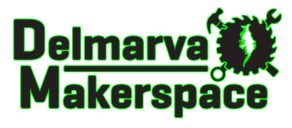As we become more aware of the environmental and economic costs of our “throwaway” culture, a new movement is gaining traction: DIY repair. More people are discovering the benefits of repairing items rather than replacing them, from conserving resources to saving money and reducing waste. At Delmarva Makerspace, we’re excited to support this movement, providing the tools, guidance, and community that make DIY repair accessible, affordable, and fun.
The Cost of Replacement vs. Repair
Financial Savings When something breaks, the impulse is often to replace it—especially if the cost of a new item seems only slightly higher than the repair price. However, fixing your own items can save you a surprising amount over time. Instead of paying for a new coffee maker, repairing a broken wire or replacing a part can bring it back to life for a fraction of the cost. For larger items like appliances, the savings can be even more substantial.
Environmental Costs Beyond dollars, the environmental cost of throwing away items is staggering. Manufacturing and transporting new products consume energy and resources, contributing to carbon emissions and environmental degradation. When we replace instead of repair, we’re fueling this demand—and creating waste that ends up in landfills. Every item you repair instead of replace reduces this environmental toll, allowing you to help conserve our planet’s valuable resources.
The Environmental Impact of Repairing vs. Discarding
Waste Reduction Landfills are filling up with items that could have been fixed: electronics with minor malfunctions, furniture that just needed some reinforcement, and appliances with replaceable parts. Repairing is one way we can combat this waste crisis. By choosing to fix items instead of discarding them, you help reduce the landfill burden and make a positive impact on the environment.
Resource Conservation Repairing isn’t just about waste—it’s about preserving the resources that go into making these products. Metals, plastics, and other materials require extensive mining, refining, and production, all of which consume energy and contribute to pollution. Repairing your items conserves these resources, which benefits both the environment and the economy.
Common Items to Repair at a Makerspace
Delmarva Makerspace is the perfect environment for DIY repair. Here are just a few items you can breathe new life into with our resources:
- Electronics: Fix broken screens, replace batteries, and re-solder loose connections on devices like smartphones, tablets, and laptops.
- Furniture: Repair wobbly chairs, refinish scratched surfaces, or strengthen loose joints in wooden furniture.
- Clothing and Fabric: Use our sewing machines to mend clothing, reattach buttons, or alter garments to make them look and feel new.
- Jewelry: Replace broken clasps, polish tarnished pieces, or resize rings and bracelets.
- Small Appliances: Tackle repairs on toasters, coffee makers, and other small appliances that can often be fixed with basic electronics and mechanical know-how.
How Makerspaces Make DIY Repair Easier and More Accessible
Makerspaces like ours make DIY repair accessible to everyone by offering the right tools and a supportive community. Here’s how Delmarva Makerspace helps:
- Tools and Equipment: From soldering stations and sewing machines to woodworking tools and 3D printers, our makerspace has everything you need to fix a wide range of items.
- Workshops and Classes: We regularly host workshops that teach repair skills, from beginner-level basics to advanced techniques. These classes provide hands-on experience and expert guidance.
- Community Support: Members at Delmarva Makerspace are passionate about helping one another. Got a tricky repair? There’s always someone around to offer advice or lend a hand.
Inspiring Success Stories from Delmarva Makerspace
Nothing demonstrates the value of DIY repair like real success stories. One member recently repaired a vintage amplifier passed down from his grandfather, restoring it to its original glory. Another turned a seemingly broken blender into a working kitchen staple with just a few parts and a little patience. These stories show that with the right tools, even seemingly impossible repairs become achievable.
The Skills and Confidence You Gain from DIY Repair
When you take on a DIY repair, you’re not just saving money—you’re gaining skills and confidence. Whether it’s understanding basic electronics, learning how to use a new tool, or mastering a sewing machine, each repair adds to your skill set. And the sense of accomplishment that comes from fixing something yourself? That’s priceless.
How to Get Started with DIY Repair at Delmarva Makerspace
If you’re interested in DIY repair but don’t know where to start, Delmarva Makerspace is here to help! We offer a range of resources to get you started, including:
- Beginner-Friendly Workshops: Check our events calendar for upcoming repair classes. These are perfect for learning the basics and getting hands-on experience.
- Open Hours: During open hours, our makerspace is available for anyone to work on projects, with staff and members on hand to assist if needed.
- Repair Cafes: Our periodic “fix-it nights” bring the community together to tackle repairs on everything from electronics to furniture.
Conclusion
DIY repair is more than just a way to save money—it’s a movement toward sustainable, thoughtful living. When you repair instead of replace, you’re contributing to a better environment, gaining valuable skills, and joining a community of like-minded individuals. At Delmarva Makerspace, we’re proud to support this mission, and we invite you to join us in reducing waste, conserving resources, and bringing new life to the items you value.
So, bring in that old appliance, that broken chair, or that cherished family keepsake. At Delmarva Makerspace, we believe in the power of repair, and we’re here to help you make it happen.
